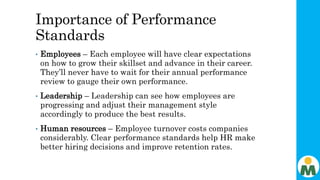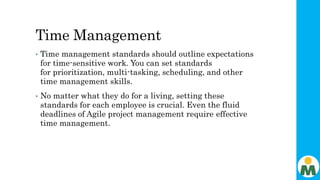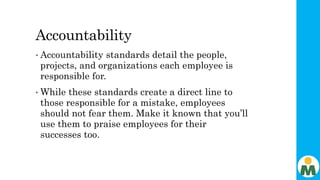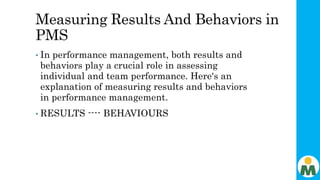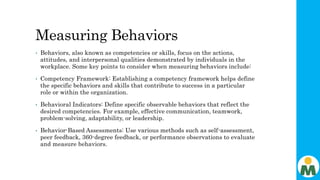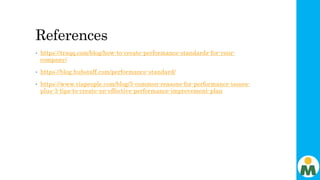PMS - Unit 3.pptx
- 2. What is Performance Monitoring? • Performance monitoring may be defined as the process of appraising an environment of continuous learning and development. It will be done by maintaining the employee’s performance, enhancing individual competencies to make them more productive for the organization. • Successful business management requires the ongoing monitoring of performance in order to generate data by which to judge the success or otherwise of specific strategies. The improvement in performance can only be realistically achieved when management is properly informed about current performance and to this end it is important to identify key performance indicators (KPIs) that will enable management to monitor progress.
- 3. Characteristics of Performance Monitoring • In organizations, a performance monitoring plan is a critical tool for planning, managing, and documenting data collection. • It is an important part of performance management system to control and measure the behaviours. • This helps in maintaining the employees’ performance as per the goals and objectives of the organization. • Performance monitoring helps in building the strong relationships between the management and employees for their efficient performance. • It facilitates career development of employees and provides the training and development opportunity to employees.
- 4. Objectives of Performance Monitoring • Timely and quality fulfillment of managing tasks and goals. • Help and support legitimately needed by the managee’s tasks, including those agreed upon during planning and review meetings. • To improve employee’s job performance as well as methods and techniques of measuring. • Introducing the continuous learning and development process. • Periodic reviews help the performance manager. • It helps in correct planning assumptions and errors mid-course before it is too late. • It monitors and encourages progress, and keep the work on track. • It strengthens a dyadic relationship between the manager and the employee.
- 5. Process of Performance Monitoring • Periodic written reports. • Scheduled meetings. • On-the-spot inspections, or field or site visits in case of employees whose location is different from that of the manager. • Relevant and reliable information from other available sources.
- 6. Importance of Performance Monitoring • Performance monitoring provides scope for modification, change, and or alteration of the existing performance management system as per the outcomes measured in the process. • It helps in reviewing and correcting performance objectives. Because it is linked to the mission and objectives of the organization. • It identifies areas for competency improvement for the overall development of employees and the organization. • It continually enhances the performance of employees and making them efficient. • It helps in realizing the full potential of employees and organizations for excellence in performance.
- 7. Performance Standard • A performance standard is a set of guidelines outlining job responsibilities and overall expectations for each employee. These standards are typically part of the organization’s larger performance management strategy. • The purpose of performance standards is to set expectations for new employees before they begin the onboarding process. This way, they have a way to gauge success and know where they stand on a day-to-day basis.
- 8. Importance of Performance Standards • Employees – Each employee will have clear expectations on how to grow their skillset and advance in their career. They’ll never have to wait for their annual performance review to gauge their own performance. • Leadership – Leadership can see how employees are progressing and adjust their management style accordingly to produce the best results. • Human resources – Employee turnover costs companies considerably. Clear performance standards help HR make better hiring decisions and improve retention rates.
- 9. Types of performance standards • Performance standards typically differ based on industry, job description, salary, and a number of other factors. That said, there are a few key standards that work for all job descriptions: • Teamwork and communication • Time management • Accountability • Technical standards
- 10. Teamwork and communication • Teamwork and communication standards evaluate employees’ ability to communicate and collaborate well. Depending on the employee’s job responsibilities, subtopics might include: • Ability to write clear and concise emails • Willingness to practice active listening • Commitment to diversity and inclusion • Typically, these standards define the audience with which the employee will communicate. That could include fellow employees, clients, customers, or all of the above.
- 11. Time Management • Time management standards should outline expectations for time-sensitive work. You can set standards for prioritization, multi-tasking, scheduling, and other time management skills. • No matter what they do for a living, setting these standards for each employee is crucial. Even the fluid deadlines of Agile project management require effective time management.
- 12. Accountability • Accountability standards detail the people, projects, and organizations each employee is responsible for. • While these standards create a direct line to those responsible for a mistake, employees should not fear them. Make it known that you’ll use them to praise employees for their successes too.
- 13. Technical Standards • Finally, the employer may set standards around the technical aspects of an employee’s performance. This might include: Earning or remaining compliant with certifications Learning new programming languages Meeting GDPR compliance standards for devices Completing security training • Technical standards should also include deadlines for addressing competencies, certifications, and compliance standards and include instructions on how to complete them.
- 14. How To Set Performance Standards • Setting performance standards is most successful when you follow the 7 step process that ensure they will be objective, measurable, realistic, and clearly stated: 1. Review the current job description. 2. Discuss with the employee how their daily duties do or do not align with the job description. 3. Review past performance goals and whether or not the employee has been able to achieve them.
- 15. How To Set Performance Standards 4. Determine what values are most relevant to your organization and the employee. 5. Choose the distinct areas or parameters that would be considered successful in the employee’s job. 6. Find metrics that can reliably measure these parameters on an ongoing basis. 7. Create a rating system (usually between 1 and 5) to evaluate employee performance against the standards.
- 16. Diagnosing the causes of poor performance:
- 17. Diagnosing the causes of poor performance: • Lack of knowledge/skills • Unrealistic expectations • Unclear agenda/goals • Lack of motivation • Job misfit • Lack of PAW – Possibility, Ability, Willingness
- 18. Addressing Performance Issues • Define expected performance, behavior, and results. • Assess actual performance, behavior, and results. • Identify the cause(s) of poor performance. • Create targeted solutions and implement those solutions. • Ensure ongoing follow-up.
- 19. Measuring Results And Behaviors in PMS • In performance management, both results and behaviors play a crucial role in assessing individual and team performance. Here's an explanation of measuring results and behaviors in performance management. • RESULTS ---- BEHAVIOURS
- 20. Measuring Results • Results refer to the outcomes and achievements attained by individuals or teams. It involves measuring the tangible and measurable outcomes of their work. Some key points to consider when measuring results include: • Clear Goals and Objectives: Results measurement starts with setting clear and specific goals and objectives that align with organizational priorities. • Key Performance Indicators (KPIs): Establishing relevant KPIs enables the measurement of progress towards goals and helps evaluate the level of success. • Quantifiable Metrics: Using quantifiable metrics allows for objective measurement and comparison of results. These metrics may include sales figures, production targets, customer satisfaction ratings, or financial performance indicators. • Performance Evaluation: Regularly assessing and comparing actual results against established goals and targets helps identify achievements, gaps, and areas for improvement. • Feedback and Recognition: Providing feedback and recognizing individuals or teams based on their results can reinforce positive performance, motivate continued success, and drive accountability.
- 21. Measuring Behaviors • Behaviors, also known as competencies or skills, focus on the actions, attitudes, and interpersonal qualities demonstrated by individuals in the workplace. Some key points to consider when measuring behaviors include: • Competency Framework: Establishing a competency framework helps define the specific behaviors and skills that contribute to success in a particular role or within the organization. • Behavioral Indicators: Define specific observable behaviors that reflect the desired competencies. For example, effective communication, teamwork, problem-solving, adaptability, or leadership. • Behavior-Based Assessments: Use various methods such as self-assessment, peer feedback, 360-degree feedback, or performance observations to evaluate and measure behaviors.
- 22. Measuring Behaviors: • Development Plans: Identify areas for improvement based on behavioral assessments and create individualized development plans to support skill enhancement and growth. • Training and Coaching: Provide targeted training and coaching to help employees develop the desired behaviors and competencies identified through performance management processes. • Continuous Improvement: Encourage ongoing feedback, reflection, and learning to foster a culture of continuous improvement in behaviors and competencies.
- 23. What to measure RESULTS/BEHAVIOUS? • It is important to strike a balance between measuring results and behaviors to provide a comprehensive assessment of performance. While results focus on outcomes, behaviors are essential for understanding how those outcomes are achieved and sustained over time. Both aspects contribute to the overall effectiveness and success of individuals and teams within the organization.
- 24. References • https://traqq.com/blog/how-to-create-performance-standards-for-your- company/ • https://blog.hubstaff.com/performance-standard/ • https://www.viapeople.com/blog/5-common-reasons-for-performance-issues- plus-3-tips-to-create-an-effective-performance-improvement-plan
- 25. THANK YOU








